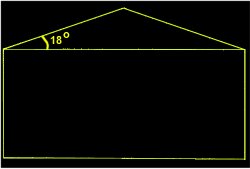| The Golden Ratio is represented by the Greek
symbol Phi One definition of Phi is that to square it you just add 1 or, in mathematics: Phi2 = Phi + 1 In fact, there are two numbers with this property, one is Phi and another is closely related to it when we write out some of its decimal places. Here is a mathematical derivation of the two values:- Multiplying both sides by Phi gives a quadratic
equation:
By solving this quadratic equation, you find that the 2 possible values of Phi are: 1·6180339887...(Phi) and –0·6180339887... (phi) Phi is a mathematical constant used in the calculation of Fibonacci numbers. The nth Fibonacci number, Fn, is calculated as follows : F1 = 1 Fn = Fn-1 + Fn-2
The Golden Ratio to the first 50 decimal points is : 1.618033988749894848204586834365
Other designs of the golden proportion :
|
Ancient Greeks adopted the Divine Ratio as sacred
measure and aesthetic proportion in art and architecture. Greeks sought
divine guidence at the Oracle of Del-PHI, whose symbol was a serpent coiled
around an egg. The Greeks thought it was the most pleasing proportion to
the human eye. Parthenon was designed using this golden proportion.
18 is again another unique number, because
"The Golden Ratio manifests in the whole of creation. Take the ratio
of the length of a man and the height of his navel. The ratio of the sides
of the Great Temple. The ratio between the long and short sides of a pentagram.
Why is this? Because the ratio of the Whole to the Greater is the ratio
of the Greater to the Lesser."
References: Golden Ratio by Alex Bonjour, Alex.Bonjour@Rose-Hulman.Edu (source: internet) PHI: The Divine Ratio - Life's Archetypal Architecture by David Yarrow, October 1996 The Golden Section Ratio: Phi by Dr Ron Knott, R.Knott@surrey.ac.uk (source: internet)
|
 &
& 



